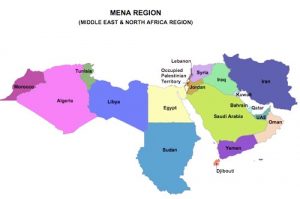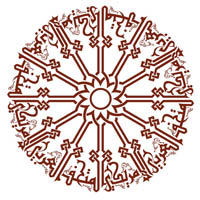New Ambiance–New U.S. Policy?
by Curtis F. Jones
By the early 1800’s, the Safavid Empire in Persia had collapsed, and the Ottoman Empire was losing the control it had exercised over the rest of the Middle East – leaving a vacuum of power across the region. As Baruch Spinoza noted in the 1600’s, nature abhors a vacuum. The logical successor to the Ottoman Sultans was their mutinous representative in Egypt, Muhammad ‘Ali, who by 1839 had defeated an Ottoman force in southern Turkey.
By this time, however, the Middle East was falling under the dominion of a still stronger force – European imperialism. Unable to resolve their own power struggle, the European powers had fallen victim to the illusion that conquests overseas would generate power at home. United in this belief, they reached agreement that weak Ottoman rule was preferable to strong Egyptian rule, so they forced Muhammad ‘Ali to bring his forces home. If they couldn’t have the Middle East, no one could.
 By the end of World War I, Britain, France, and Russia had carved up the Middle East into possessions, protectorates, “colonies”, and “mandates” – one of the euphemisms politicians find essential. The exception was Turkey; having expelled Allied and Greek forces, Mustafa Kemal Ataturk began the long process of secularizing Turkey and establishing the first truly independent post-imperialist state in the region.
By the end of World War I, Britain, France, and Russia had carved up the Middle East into possessions, protectorates, “colonies”, and “mandates” – one of the euphemisms politicians find essential. The exception was Turkey; having expelled Allied and Greek forces, Mustafa Kemal Ataturk began the long process of secularizing Turkey and establishing the first truly independent post-imperialist state in the region.
After World War II, their second civil war in thirty years, the exhausted European imperialists entered a new era of sanity – facing up to the reality that Europeans needed to stop shooting each other, and to abandon their fantasies of world empire.
Not having learned this crucial lesson, the Americans took Europe’s place in the imperialist trap. Activated by exaggerated fears about access to oil and the hobgoblin of “world communism”, and sublimely oblivious to the traumatic implications of Zionism, Washington began its fateful intrusion into the savage politics of the Middle East by issuing a blanket guarantee of the frontiers of Saudi Arabia, and presiding over the insertion of a Jewish state into the endemic battleground that was the Fertile Crescent.
 In 1956 Britain and France made one last effort to resuscitate European imperialism by colluding with Israel in the Suez War. Their scheme was so infantile and clumsy that it infuriated Eisenhower, who expelled the British and French invaders from the Suez Canal Zone. He also expelled the Israeli forces from Sinai and the Gaza Strip — thereby taking the first step in the long process of determining Israel’s defensible borders.
In 1956 Britain and France made one last effort to resuscitate European imperialism by colluding with Israel in the Suez War. Their scheme was so infantile and clumsy that it infuriated Eisenhower, who expelled the British and French invaders from the Suez Canal Zone. He also expelled the Israeli forces from Sinai and the Gaza Strip — thereby taking the first step in the long process of determining Israel’s defensible borders.
In 1973 Sadat masterminded the Yom Kippur war, in which Egypt and Syria — before Israel’s inevitable victory — scored sufficient initial success to enable Sadat to come out of the conflict with the claim that Egypt had avenged its humiliation by Israel in the Six-Day War of 1967. Thus he set the domestic political stage for the Camp David Accord, whereby in return for a free hand in the crucial West Bank, Israel returned what Sadat really wanted, Sinai. Sadat also won the bonus of a considerable subsidy from Washington.
Sadat’s Egyptian constituency was unforgiving of the sell-out of the Palestinians, and the lurch to the West. These actions were major issues in the assassination of Sadat by Islamists in 1981, and the ouster of Husni Mubarak in 2011. Meanwhile, however, Sadat had concluded with Israel the notorious 1979 peace treaty, which is still in effect, and which was followed up by Yasir ‘Arafat’s capitulation to the fraudulent Oslo Agreement of 1993, and by King Husayn’s adroit exploitation of that precedent in his conclusion of a Jordanian peace treaty with Israel in 1994.
Those events were the sum total of accomplishment on the Arab-Israeli diplomatic front. Political opposition to the Israeli-American diarchy has been building up across the region. To quell it, America and/or Israel have resorted to a multifarious campaign of coercion:
Indigent minions are subsidized (Israel, the house-broken wing of the Palestinian resistance, Yemen, Jordan, Egypt after Jimmy Carter’s hypothetical triumph at Camp David in 1978). Weak minions get military support (Pahlevi Iran, Georgia, the five Arab states on the Gulf, Saudi Arabia, Iraq until its invasion of Kuwait in 1990).

Intractable parties receive rough treatment: subversion (Iran in 1953; Syria [abortive] in 1957; Iraq, in collusion with the Ba‘th, in 1963; Iraq in 1996; the recent Stuxnet attack on Iranian nuclear installations); assassination (Israeli operations against the Palestinian leadership from 1972 to the present; failed Saudi-American attempt against a Hizballah leader in 1985; killings of Iranian nuclear scientists in the 2000’s; continuing American operations against Al Qa‘idah by raids and drone aircraft); and conquest (Israeli capture of three-fourths of Palestine in 1948; Israel’s capture of the rest of Palestine and Syria’s Golan in 1967; Israel’s occupation of Sinai, 1967-79; Israel’s occupation of southern Lebanon, 1978-2000; America’s abortive participation in the invasion of Lebanon, 1983; America’s destruction of half the Iranian fleet during the Iraq-Iran War of 1980-88; American invasion of southern Iraq, 1991; Israeli incarceration of the Gaza Strip from 2005 to the present time; American occupation of Iraq, 2003 through 12/31/2011).
Washington’s coercion strategy has foundered. Aside from its questionable legality and the failed initiatives, it has suffered bruising setbacks:
1979 – Citing America’s pattern of venal intrusion in Iranian affairs, a theocratic regime ousted the Shah and instituted a virulently anti-American policy.
1990 – Drawing erroneous inferences from Washington’s misguided partisanship in the Iraq-Iran War, Saddam invaded Kuwait, switching overnight from ally to enemy.
2000 – Hizballah and allies finally harried Israeli forces out of Lebanon – establishing another segment of Israel’s defensible frontier, the old Lebanon-Palestine line, and demonstrating that the diarchy, invincible in conventional warfare, is vulnerable in asymmetric warfare.
2001 – The American intelligence failure that led to the attacks of 9/11.
2006 – Second Hizballah guerrilla victory.
2008 – Israel’s aerial devastation of the Gaza Strip damaged Israel’s image. American support for that offense damaged the longstanding alliances with Saudi Arabia and Turkey.2011 – Although the Arab Spring has not reached the stage of revolution anywhere in the Middle East, the ouster of pro-American kingpin Mubarak in Egypt, the liberal uprising in Syria, and Washington’s failure to extract from the puppet Maliki regime in Baghdad authorization for extension of troop deployment beyond the SOFA deadline, combine in revealing the fragility of a policy based on the illusory permanence of the political status quo – despots and all.
Americans seeking reassurance that hard-line policies are still in effect can point to the obduracy of Prime Minister Netanyahu; to Obama’s endorsement of the Saudi foray in support of the beleaguered autocracy in Bahrain; to Saudi reliance on the American security guarantee – and Saudi tolerance of Reagan’s quixotic guarantee of the Saudi monarchy itself; to Turkey’s acceptance of the stationing of NATO defensive missiles; to Congressional alacrity in confirming its standard policy of cutting off aid to UNESCO and any other UN agency that accords the Palestinians membership; and to Obama’s wholesale use of drone aircraft in ways that seem to contravene the Fifth Amendment.
 Simultaneously, however, we see hints that the hard-line approach is being implicitly adulterated: Bush’s rejection of Israel’s 2008 request for logistic assistance for an air attack on nuclear installations in Iran; the sharp contrast between the essentially unilateral invasion of Iraq for no plausible reason, and Washington’s low-key participation in NATO’s measured aerial campaign against a murderous regime in Libya; tolerance of the ouster of the pro-diarchy dictator in Egypt; imposition of sanctions against a relatively cooperative dictator in Syria, along with official statements that he must go.
Simultaneously, however, we see hints that the hard-line approach is being implicitly adulterated: Bush’s rejection of Israel’s 2008 request for logistic assistance for an air attack on nuclear installations in Iran; the sharp contrast between the essentially unilateral invasion of Iraq for no plausible reason, and Washington’s low-key participation in NATO’s measured aerial campaign against a murderous regime in Libya; tolerance of the ouster of the pro-diarchy dictator in Egypt; imposition of sanctions against a relatively cooperative dictator in Syria, along with official statements that he must go.
Against this ambivalent background, traumatic contingencies loom ahead. The focus of instability would appear to be the Fertile Crescent, a volatile block of territory that reflects 5000 years of close association, but is still bitterly fragmented in at least four ways:
Politically, it is cut up among five sovereign states (Iraq, Israel, Jordan, Lebanon, Syria), two determined claimants to statehood (Kurdistan, Palestine), and several disputed enclaves.
Denominationally, it arrays adherents of at least six rival communities (Alawite, Sunni, and Shiite Muslims; Catholic and Orthodox Christians; Jews).
Linguistically, it is fractured among four major language groups (Arabs, Jews, Kurds, Turkmens) and numerous smaller ones.
Dynastically, it contains five recognized regimes (Maliki Government in Iraq, Netanyahu Government in Israel, Hashemite Monarchy in Jordan, Sulayman/Hariri Government in Lebanon, Asad dictatorship in Syria) and five active challengers (Kurdish Regional Government in Iraq, Hizballah in Lebanon, Fatah organization in the West Bank, Hamas organization in the Gaza Strip, and the Syrian National Council – based in Turkey).
For full appreciation of the ephemerality of political entities in this segment of the Middle East, we have to add to the mix the several unification projects that had appreciable support: 1919 — the call by the “General Syrian Congress” for a state consisting of Syria, Lebanon, Palestine, and Jordan; 1949-67 — Transjordan’s annexation of the West Bank; 1958-61 —The United Arab Republic of Egypt and Syria; 1958 – the Hashimite federation of Iraq and Jordan; 1964 — Iraqi ruler ‘Abd al Salam ‘Arif’s promotion of union with Egypt; 1967 – the Israeli annexation of an expanded East Jerusalem and the Syrian Golan, and the occupation and sequential settlement of the rest of the West Bank; 2005 – the incarceration of the Gaza Strip, after all Jewish residents had been removed; 1979 – Iraqi leader Ahmad al Bakr’s secret approach to Hafiz al Asad in favor of Iraqi-Syrian union; 1990 — abortive attempt by Saddam to annex Kuwait.![]()

Curtis F. Jones was a U. S. Foreign Service officer from 1946 until his retirement in 1975. A fluent speaker of Arabic, he served most of those years in the Middle East or in positions in Washington concerned with Middle Eastern affairs. Mr. Jones is a graduate of Bowdoin College and the U. S. Naval War College. He is a member of the board of directors of American Diplomacy Publishers and a frequent commentator on foreign policy issues.
